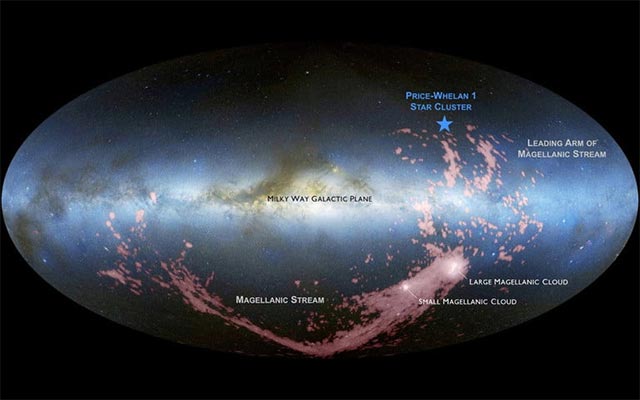The interaction between the Milky Way and a satellite galaxy is creating many new stars
According to a widely accepted forecast in global astronomy, in about 2 billion years, our galaxy (Milky Way) will collide with an adjacent satellite galaxy: Large Magellanic Cloud (LMC). This collision is so dramatic that it will wake the black hole in the center of our galaxy, make it work again, and rapidly expand to ten times its current size.
The LMC is a fairly small galaxy, but very rich in dark matter, so it has an enormous mass. This feature makes the collision between the two galaxies extremely catastrophic.
But that is the story of the future 2 billion years from us. At the present time, the interaction between the two galaxies not only does not cause damage, but also contributes to the creation of new stars.
Based on data obtained from the Gaia spacecraft, researchers have found the existence of rare blue stars and satellite star clusters traveling with them in our Galaxy. After identifying and removing known clusters, scientists found a cluster of stars on the far edge of the Galaxy with many interesting features, named Price-Whelan 1.

By analyzing the elements found in the new cluster's stars, the researchers realized that they are likely to be formed from celestial bodies located outside our galaxy. This mysterious cluster is located near a stream of gas called the Magellanic Stream, which flows from the Large and Small Magellanic Cloud toward the Galaxy, so scientists believe that the interaction between another galaxy and the Milky Way is elements that create the source of the materials that make up the stars.
This is a giant cluster. It contains less than a few thousand stars, but has an impact beyond the Milky Way. It represents the ongoing interaction between the Milky Way and the Large Magellanic Cloud.
You should read it
- Cosmic Science: The star system TRAPPIST-1 does not 'exist' the big Moon
- Cosmic science: Inclined planets around small stars can hardly survive life
- Discover incredible facts about our cosmic planet
- The surface of Venus: Why is Venus the hottest planet in the solar system?
- Detects the hottest outer planet in the universe, with temperatures up to 4,327 ° C
- 'Planet Hunters' are looking for signs of extraterrestrial life around nearby stars
 Found the oldest solid material on Earth, 'older' than the Sun.
Found the oldest solid material on Earth, 'older' than the Sun. 13 interesting facts in life not everyone knows
13 interesting facts in life not everyone knows What is a solar eclipse? When does a solar eclipse take place?
What is a solar eclipse? When does a solar eclipse take place? Is the alcohol meter accurate?
Is the alcohol meter accurate? How to solve the problem quickly at home
How to solve the problem quickly at home These are secret areas on the plane that visitors are not allowed to sneak to
These are secret areas on the plane that visitors are not allowed to sneak to